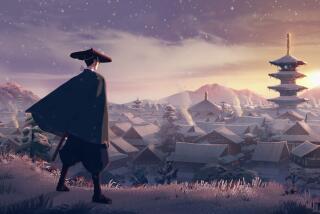Power Rangers are back in the picture
They’ve morphed once more.
Eighteen years — and 15 iterations — after they premiered, the Power Rangers are still demonstrating their mighty morphin’ abilities. Now Nickelodeon is introducing a new generation of kids to the long-running franchise of teenage costumed heroes with the prime-time premiere Monday of the live-action series “Power Rangers Samurai.”
“The show has been a point of entry into action adventure, sci-fi and fantasy for young children for so many years,” said Pete Danielsen, executive vice president of programming for Nickelodeon/MTVN Kids and Family Group. “And we hope that remains true as we add it to our lineup.”
In the new edition, shot in New Zealand, five spirited teens battle monsters under the guidance of a samurai mentor to save the world.
“There’s no other show for kids that has this kind of action and adventure,” said the newly minted red Ranger Alex Heartman, who as a kid dressed as the original red Power Ranger for a few Halloweens.
As Saban Brands reboots the Japanese import on a global scale, plans are to have the series run over two seasons — about 40 episodes — before rotating in a new edition.
The relaunch of “Power Rangers” on Nickelodeon was announced last May, after media mogul Haim Saban bought back the rights to the property that had helped him gain dominance in children’s programming in the 1990s, from Walt Disney Co., which took control in 2001.
“Nick has the lion’s share of the marketplace, in terms of their ability to reach kids across the world,” said Elie Dekel, president of Saban Brands. “Under the Disney era, we had isolated programming that was somewhat difficult to find. The fact that [‘Power Rangers’] is a priority for Nick means that it’s getting more promotion, it’s getting a lot more visibility within all their platforms.”
Despite the franchise’s evolution over 19 seasons (and two movies), the newest rendering preserves much of the campy feel of the low-budget debut, “Mighty Morphin Power Rangers,” that launched the series. Saban even brought back original executive producer Jonathan Tzachor.
“Bringing back [Tzachor] was a key factor in getting back some of the magic in the show,” Dekel said. “We spent a fair amount of time in watching and reminding ourselves what the show was all about at its inception, and we worked hard with the writing and production team to make sure that DNA was there.”
That foundation — friendship, teamwork, action, empowerment — is what has contributed to the franchise’s longevity, even if some iterations did it better than others.
“All kids imagine being a superhero,” said Walter Jones, who played Zack Taylor on the original series. “Kids clung to the Power Rangers because they felt they could morph into us in their imagination. And they could do it with their friends.”
And in a further attempt to recapture the series’ former glory, a big-screen adaptation is possible; the last, “Turbo: A Power Rangers Movie,” was released in 1997.
“We are going to be looking at a feature film for Power Rangers in the foreseeable future,” Dekel said. “It’s absolutely within our strategy, but nothing is yet firmed.”
Nickelodeon, Disney’s primary competitor in the children’s TV business, will air 20 new episodes of “Power Rangers,” along with a catalog of more than 700 episodes, as part of the deal with Saban. And it’s not the only nostalgic property on the Viacom Inc.-owned network; it will soon relaunch the popular 1980s cartoon series “Teenage Mutant Ninja Turtles.”
Much of the hysteria that marked “Power Rangers’” early years — parents camping out to buy coveted action figures or frenzied reactions now more likely to be displayed for the likes of Justin Bieber — has ebbed as the era of children’s television has become more fragmented. But the Saban series continues to remain a rite of passage for young children, particularly among boys.
“Children really gravitate toward these characters because they are powerful and represent something good in their eyes,” said Karen Sternheimer, a sociology professor at USC. “It’s a way for them to live vicariously in a world where they are otherwise powerless.”
Though parents have criticized “Power Rangers” over its life span for its violence, that hasn’t prevented it from becoming a cash-making machine. Power Rangers licensed products and promotions have generated well over $5 billion in retail sales worldwide, according to Saban Brands. And since its inception, Bandai — the master toy licensee for “Power Rangers” — has sold more than 200 million Power Ranger toys in the U.S.
That number is likely to increase as modern Power Ranger Samurai battle gear, like the Samuraizer Morpher and Samurai Spin Sword, hit store shelves.
Oh, if Zordon could see them now.
More to Read
The biggest entertainment stories
Get our big stories about Hollywood, film, television, music, arts, culture and more right in your inbox as soon as they publish.
You may occasionally receive promotional content from the Los Angeles Times.











